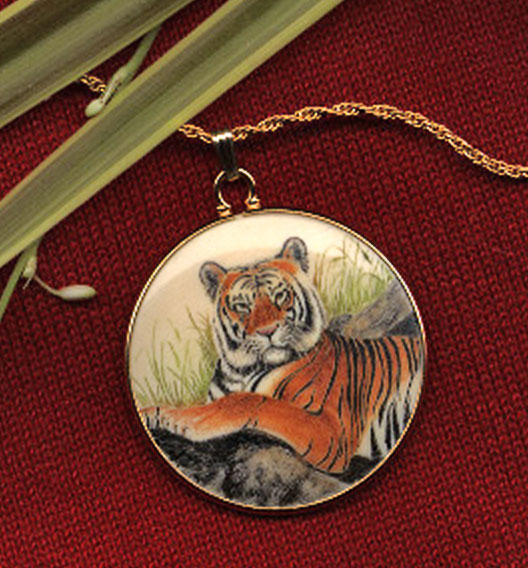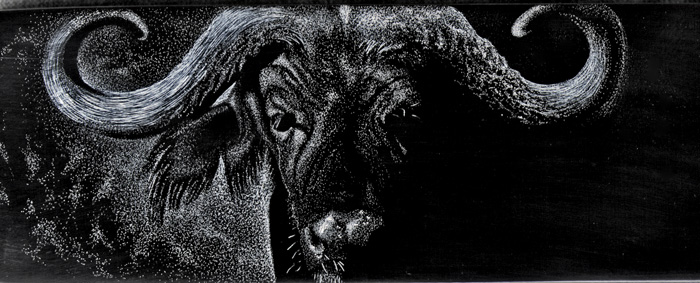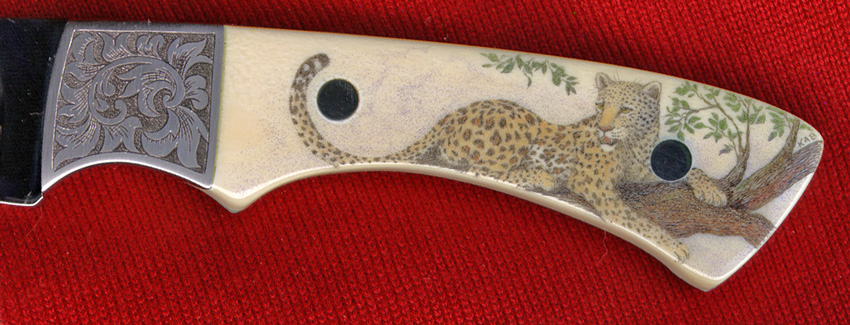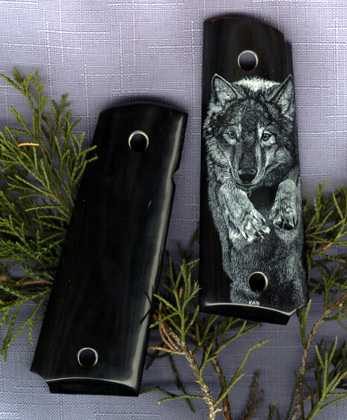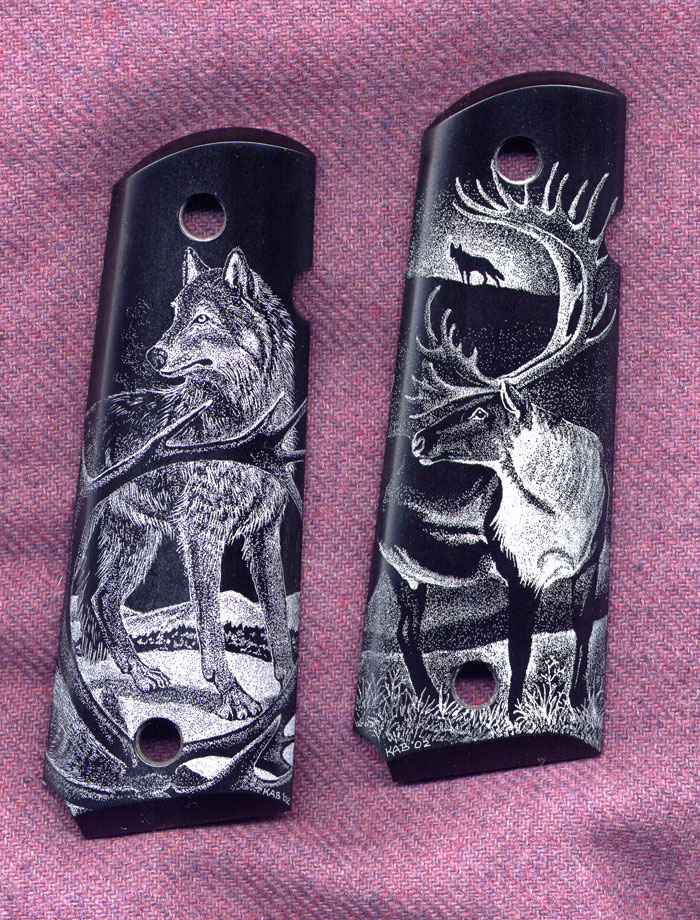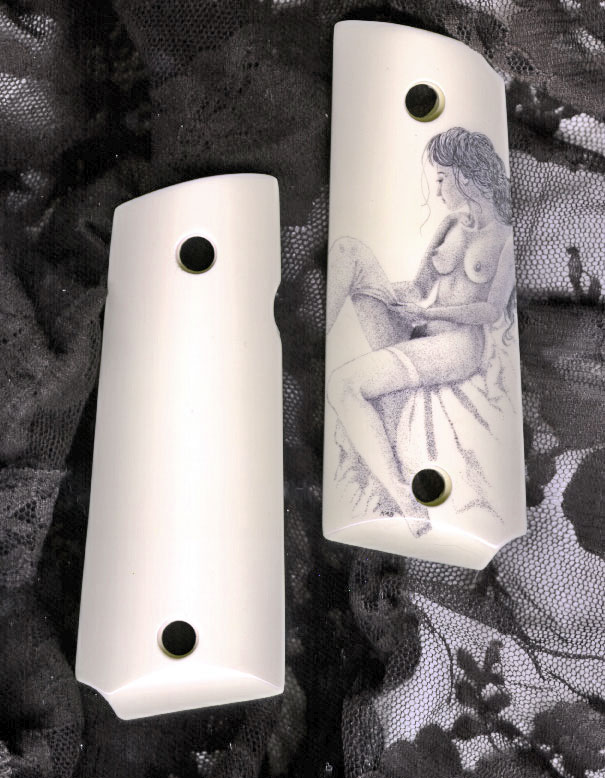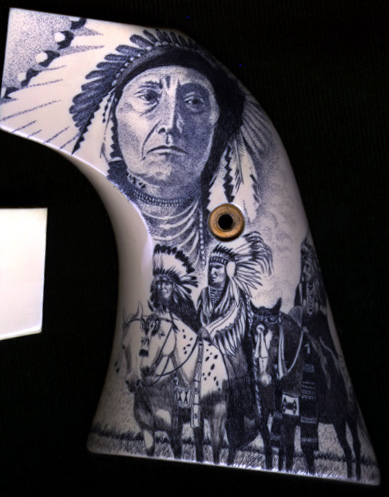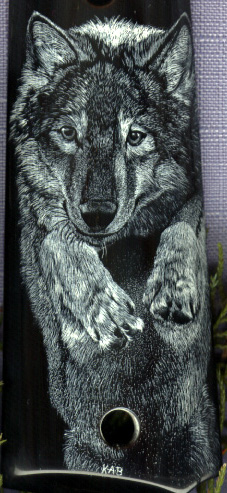Shown below is a 38mm round (silver dollar size) pendant in estate elephant ivory with gold-filled findings, with scrim in full color. This was another one of my early pieces. Please excuse the quality of this photo. I neglected to capture a hi-res photo of it before selling it.
Tag: Scrimshaw
Cape Buffalo in Reverse Scrimshaw on Black Buffalo Horn
Below is a slab of black water buffalo horn showing a very dangerous customer waiting in the shadows. The technique is reverse scrimshaw, which is much more time consuming than traditional scrimshaw, but the results are worth it. The play of light and texture is hard to achieve with traditional white on black scrimshaw.
Leopard Color Scrimshaw on Ivory Hunter
Below is a hunting knife by Tommy McNabb of Carolina Custom Knives with estate elephant ivory handles and engraved bolsters. The leopard in the tree was scrimmed in full color on one side; knife supplied by the maker.
Tools Used in Scrimshaw
The most basic tools anyone needs for scrimshaw are a sharp needle and a rag–the needle for piercing or scratching the material to be scrimmed and the rag for rubbing away excess pigment. Of course, you won’t get the best results with only these two tools. Other basic tools needed for serious scrimshanding include: Sandpaper… Continue reading Tools Used in Scrimshaw
Colt Model 1911 Hand-scrimmed Leaping Wolf Grips
I scrimmed these Model 1911 DHT Innovations durable resin grips grips with my most popular design (the leaping wolf) in 2009. Of course, this is reverse scrimshaw (white on black). I prefer to scrim reverse on black buffalo horn, but I wanted to test these grips to see how they scrimmed. The detail is good,… Continue reading Colt Model 1911 Hand-scrimmed Leaping Wolf Grips
Set of Wolf & Caribou 1911 Grips in Reverse Scrimshaw
I scrimmed these grips as a matched set for a client who wanted them for a pair of 1911 handguns. I scrimmed them in reverse on black paper micarta grips. Each grip includes elements of the caribou and wolf. Both the client and I were very satisfied with the way this set came out.
Nude on Bonded Ivory 1911 Grips
Another nude, this time on standard Colt 1911 bonded ivory grips.
Dall Sheep on Ken Steigerwalt Ivory Folder
Below is a folding pocketknife with estate elephant ivory handles by Ken Steigerwalt. Scrim is in full color on both sides. This knife won the Best Scrimshaw Award at the 1997 SouthEastern Custom Knife Show. NOTE: Please excuse the quality of the photo. This was an early photo made on a flatbed scanner.
Nude on Ivory Colt 1911 Officers Grips
Below is a Colt Model 1911 Officers Model pistol grips in estate elephant ivory. I scrimmed this young lady au natural on the customer-supplied ivory grips. Ivory grips can be pricey, but they tend to age beautifully. However, I don’t recommend them on a gun you plan to shoot. The stress from firing can cause… Continue reading Nude on Ivory Colt 1911 Officers Grips
Chief Joseph on Ruger Single Six Bonded Ivory Grips
Below is a pair of Ruger revolver grips in bonded ivory (a mixure of powdered ivory and resin). These attractive grips were scrimmed on both sides with a theme honoring Chief Joseph. The challenge of scrimming portraits is that there is little room for error if you want your subject to be recognized. That means… Continue reading Chief Joseph on Ruger Single Six Bonded Ivory Grips
Leaping Wolf Colt 1911A Grips In Black Buffalo Horn
Below is a pair of Colt Model 1911 pistol grips in genuine black water buffalo horn. These lustrous pistol grips were scrimmed in a technique called “reverse scrimshaw,” which is white on black. The challenge of reverse scrimshaw is that you are drawing the opposite of the way you would on paper (black on white).… Continue reading Leaping Wolf Colt 1911A Grips In Black Buffalo Horn
What Is Scrimshaw?
Scrimshaw is an ancient art form that has only recently realized its potential. Today’s scrimshanders (scrimshaw artists) have achieved beauty and detail unimagined by even the whalers of the nineteenth century. Scrimshaw is the process of scratching or piercing a hard material like ivory, bone, or antler, rubbing pigment into the marks or designs, then… Continue reading What Is Scrimshaw?
Materials Used In Scrimshaw
The base of any piece of scrimshaw should be a smooth, relatively hard material that is finished (polished) to a high degree. Traditionally, most scrimshaw was produced on teeth, tusks, antler, or bone. Materials I will scrim Light-colored materials (for black & white/color scrimshaw) Elephant tusk ivory (pre-ban ivory from estates in the US) Fossilized… Continue reading Materials Used In Scrimshaw
